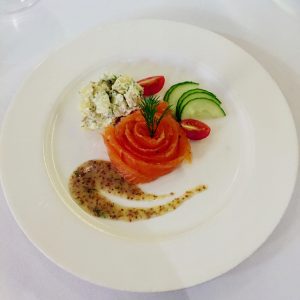
One of the first things I tasted aboard Viking Ocean’s Homeland cruise was an artfully arranged serving of Gravlax. It was beautifully served in The Restaurant aboard Viking Star as we sailed for Denmark. I liked it so much, it was the first of many times I had Gravlax aboard ship.
Now to a New Yorker, Cured Salmon is practically an indigenous food. This is especially true of “Lox” which derived its name from the Yiddish word for salmon: laks. It is sometimes called “Nova”, a tribute to Nova Scotia where it was caught. And of course, there’s also Smoked Salmon. They’re quite different. Lox is never cooked and it is only made from the salmon’s belly which is then cured in a salty brine. Smoked Salmon, while similarly salt-cured, can come from any part of the fish and not just the belly. It’s either cold-smoked, which makes its texture similar to lox and gravlax, or hot-smoked which gives it a firm, flakiness and smoky flavor.
Gravlax is similar to Lox and to Cold-Smoked Salmon. But instead of a simple salt brine, the traditional 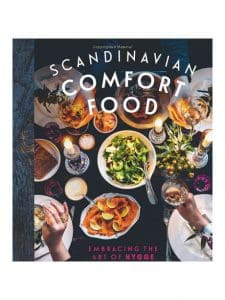 Nordic recipe calls for a cure of three ingredients: Salt, Sugar and a whole lot of dill. There are variations including ones that use Horseradish and aquavit or vodka. Today’s recipe comes from the cookbook “Scandinavian Comfort Food”(Quadrille UK 2012) which I wrote about in my last post. Its author, Trine Hahnemann, says that when she was growing up Salmon was wildly expensive and so Gravlax was a treat reserved for the holidays, specifically Christmas. Now that the fish is widely farmed in Norway, Salmon is far more common on Scandinavian tables. And her recipe revolves not around dill but around Juniper Berries, coriander seed, black peppercorns, sea salt and Caster Sugar, a superfine form of sugar. ( In a pinch, you can use your food processor to grind regular sugar down in size.)
Nordic recipe calls for a cure of three ingredients: Salt, Sugar and a whole lot of dill. There are variations including ones that use Horseradish and aquavit or vodka. Today’s recipe comes from the cookbook “Scandinavian Comfort Food”(Quadrille UK 2012) which I wrote about in my last post. Its author, Trine Hahnemann, says that when she was growing up Salmon was wildly expensive and so Gravlax was a treat reserved for the holidays, specifically Christmas. Now that the fish is widely farmed in Norway, Salmon is far more common on Scandinavian tables. And her recipe revolves not around dill but around Juniper Berries, coriander seed, black peppercorns, sea salt and Caster Sugar, a superfine form of sugar. ( In a pinch, you can use your food processor to grind regular sugar down in size.)
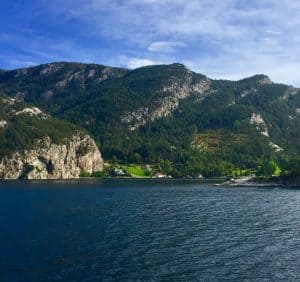
Gravlax is breeze to make. And if I had any questions about sustainability, they were all swept away when we reached Norway. There from the deck of Viking Star we saw fish farm after fish farm. Aboard an excursion boat out of Stavanger, we came closer to this center of Aquaculture which produced one of the most staggering statistics of the entire trip. Every day, 14 million meals of Norwegian Salmon are consumed in more than 150 countries around the globe. Norway is so reliant on this trade that they go to extraordinary lengths to safeguard the environment and the fish stocks essential to the future of its Aquaculture. It’s been an upward climb because farm-raised salmon has been hit hard with negative press. I am acutely aware of this not only because I write about food, but because I was astonished, if not appalled, by the fish and shellfish farming I saw in Vietnam. There, murky waters and the closeness of the fish farms to major sources of pollution was shocking. I have to say that Norway swung the pendulum completely the other way: the water is sparkling pure and the salmon farms models of cleanliness and sustainability.
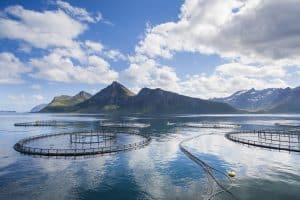
Foto: Marius Fiskum © Norges sjømatråd
Norwegian farmed salmon are not crowded into pens. Not at all. Instead Norwegian law forbids salmon making up more than 2.5 {7764cd352edcf19b608e75b52a560f8f0623df8defec59f0ed185161f2ba1413} of spacious protected ocean pens. Put another way, 97.5 percent of the volume in the salmon growing pens is made up of water. These round net enclosures are up to 650 feet in circumference and they’re up to 150 feet deep. The fish are fed a diet of both raw vegetable and raw marine materials, all-natural of course, and completely free of antibiotics. Their diet is astonishingly efficient—especially compared to other proteins: Salmon consumes a little over a third of the volume of food needed to raise pigs and less than one sixth the amount of feed necessary to produce the same amount of beef.
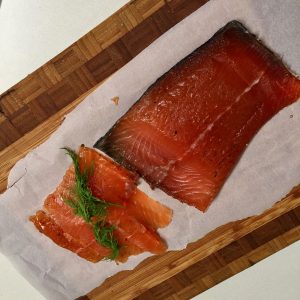 Now that your conscience is clear, you can enjoy this great treat anytime you feel inclined. The process involves nothing more than a piece of salmon, ingredients found in most pantries and a ceramic dish to house the salmon for the three days need to cure it. So you can easily make this dish on a Thursday and by Sunday morning you can uncover your Gravlax and bring out the cream cheese, the bagels or rye bread if you want to go full on Scandinavian and astonish your guests with your creativity. While the recipe calls for a whole 3 plus pound filet, you can easily just pick up a nice piece weighing about a pound and achieve the same glorious results. Here is the recipe:
Now that your conscience is clear, you can enjoy this great treat anytime you feel inclined. The process involves nothing more than a piece of salmon, ingredients found in most pantries and a ceramic dish to house the salmon for the three days need to cure it. So you can easily make this dish on a Thursday and by Sunday morning you can uncover your Gravlax and bring out the cream cheese, the bagels or rye bread if you want to go full on Scandinavian and astonish your guests with your creativity. While the recipe calls for a whole 3 plus pound filet, you can easily just pick up a nice piece weighing about a pound and achieve the same glorious results. Here is the recipe:
Juniper Cured Gravlax from Trine Hahnemann's ''Scandinavian Comfort Food''
Your own Gravlax to impress your friends!

Ingredients
- 1 tablespoon coriander seeds
- 1 tablespoon black peppercorns
- 1 3/4 tablespoon juniper berries
- 5 1/4 oz. flaky sea salt
- 1 cup caster sugar
- 1 fillet salmon (about 3lb. 8 oz.), skin on
- rye bread to serve
- horseradish cream, to serve
Directions
- Step 1 Using a pestle and mortar, lightly crush the coriander seeds and peppercorns together, then tip out into a mixing bowl and lightly crush the juniper berries. Add to the bowl with the salt and sugar and mix well.
- Step 2 Line a ceramic dish at least 16 inches long with cling film to overhang the sides, and place the salmon fillet skin-side down in the dish. Now spoon the cure mixture evenly over the salmon, making sure the whole fillet is covered. Wrap the cling film up tightly around the fillet so the mixture stays in place. Refrigerate for 3 days, to cure.
- Step 3 Rinse the cure mixture off with cold water and wipe the fish clean. To serve, cut into slices, leaving the skin behind, and eat with rye bread, a sliced baguette and horseradish cream.











